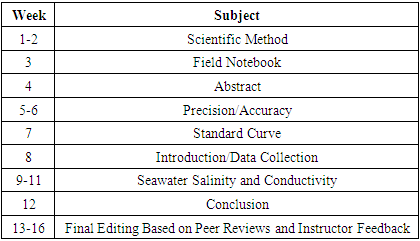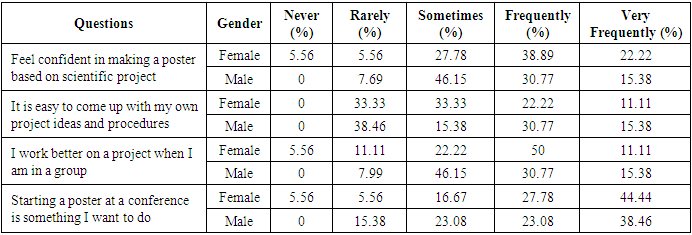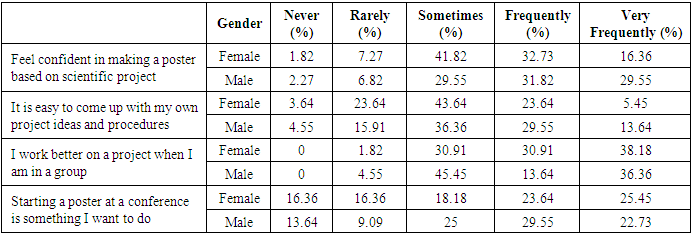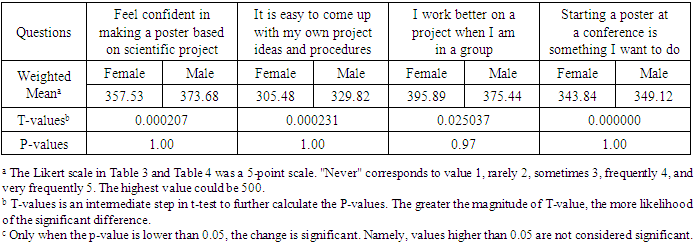-
Paper Information
- Paper Submission
-
Journal Information
- About This Journal
- Editorial Board
- Current Issue
- Archive
- Author Guidelines
- Contact Us
Journal of Laboratory Chemical Education
p-ISSN: 2331-7450 e-ISSN: 2331-7469
2022; 10(2): 38-44
doi:10.5923/j.jlce.20221002.03
Received: Jul. 17, 2022; Accepted: Aug. 10, 2022; Published: Aug. 23, 2022

Incorporating Course-based Undergraduate Research Experience into Introductory Chemistry Course; Gender Inequities in STEM Education
Alexandria Xena Singapan, Irene Lin, Taylor Yang, Jared Ashcroft
Department of Chemistry, Pasadena City College, Pasadena, United States
Correspondence to: Jared Ashcroft, Department of Chemistry, Pasadena City College, Pasadena, United States.
| Email: |  |
Copyright © 2022 The Author(s). Published by Scientific & Academic Publishing.
This work is licensed under the Creative Commons Attribution International License (CC BY).
http://creativecommons.org/licenses/by/4.0/

Approaches to student-centered active learning have evolved. The progression in course-design has led to the development of new learning paradigms such as collaborative, problem based, and project-based learning. Course-based undergraduate research experiences (CUREs) are a learning pedagogy that infuses research experiences within the curriculum. This method of instruction increases opportunities for students to participate in more authentic education experiences and is especially beneficial in the science education pathway. CUREs encourage students to be autonomous and emphasize teamwork. Our research proposes methodologies that can maximize student performance, particularly benefiting underrepresented and underprepared female students. Pre- and post- assessments of a CURE classroom were administered to gauge student engagement and success in a General Chemistry course. Specifically, our research focuses on female engagement in CURE projects and overall success and retention rates to test if the teaching methods will support increased gender equity in STEM.
Keywords: Course-based Learning, Undergraduate Education, Gender Equity, Self-Efficacy, Inquiry-based Learning
Cite this paper: Alexandria Xena Singapan, Irene Lin, Taylor Yang, Jared Ashcroft, Incorporating Course-based Undergraduate Research Experience into Introductory Chemistry Course; Gender Inequities in STEM Education, Journal of Laboratory Chemical Education, Vol. 10 No. 2, 2022, pp. 38-44. doi: 10.5923/j.jlce.20221002.03.
Article Outline
1. Introduction
- Self-efficacy is the measure of one’s ability to complete a task or a goal. Specifically, academic self-efficacy is one’s ability to master academic subjects and coursework (Usher, 2008). Students that are confident in their abilities have shown increased perseverance and persistence, are more goal oriented, and display more optimism for their subject. This in turn helps predict a student's path, such as college major and career choices, by teaching students to be problem solvers and monitor their own progress (Brown & Lent, 2006). They also work harder and engage in more self-regulatory strategies that promote success in school (Schunk & Pajares, 2005). Conversely, students with low self-efficacy prefer to complete uncomplicated tasks with minimal effort and persistence. Self-efficacy is a stronger determinant of academic success than actual skill and it may be the precursor of self-concept (Bong & Skaalvik, 2003), both of which are crucial predictors of students' performance (Choi, 2005). Previous study also suggested that female self-concept in STEM may be negatively related to gender stereotypes (Ertl et al., 2017).In the area of STEM undergraduate education, research suggests that gender is a factor affecting the performance and motivation of students. Self-efficacy with first year students in various STEM disciplines shows that males hold higher self-efficacy than women. A study that encompasses upper-division undergraduates (third and fourth year) STEM revealed that academic self-efficacy of males is higher than females beyond first year college courses. Females enrolled across all STEM disciplines reported significantly lower academic self-efficacy compared with males in STEM majors, particularly on study skills, test taking, and coping with anxiety (MacPhee, 2013). A demand for alternative teaching pedagogy has placed emphasis on the value of undergraduate research experience (Weaver, Russell and Wink 2008). Undergraduate research has been shown to be a high impact practice that is optimized by early exposure to research. It has especially shown to be effective in engaging underrepresented students in STEM (Ritcher-Egger et al., 2010). Unfortunately, undergraduate research has historically only been available and encouraged to high-performing, elite students (Fakayode, Yakubu and Pollard 2014). Gender inequalities serve as a starting point for instructors and researchers to evaluate the classroom experience for female students. In many STEM fields, females are underrepresented at an undergraduate level which is intensified at a graduate, postdoctoral, and practicing STEM at a professional level (Wang & Degol 2017). Women who initially choose majors in engineering are more likely to switch out of this major in comparison to their male counterparts (Dickinson, 2010). Although females persist through undergraduate programs, men are significantly overrepresented among doctoral degrees (Gillen, 2014). In fact, data shows that every ethnicity shows a male dominance in STEM, even though female students earn baccalaureate degrees at greater percentage than male students (Riegle-Crumb & King 2010). Focusing resources on alleviating gender inequality at an undergraduate level can increase the number of women in professional STEM fields. These resources include analyzing teaching practices and determining effective strategies to increase female engagement, retention, and success in STEM. These findings display issues females face across STEM disciplines and serve as a call for researchers and instructors to evaluate female experiences at all educational levels to better understand which gender inequalities exist in the STEM classroom.A recent curriculum shift in STEM has been the utilization of course-based undergraduate research experience (CUREs) that infuse research principles within a STEM course, allowing access to research experiences to a broader range of students. This is especially beneficial in community college settings where over half the students from underrepresented populations begin their STEM journey (Jackson 2013). The CURE approach challenges students to work with “real-life” research topics, pose questions and design an approach to obtain data. This learning scheme enables students to make informed decisions and integrate authentic research into introductory STEM courses, overall enhancing student engagement and better preparing them for future STEM coursework. The traditional and CUREs classrooms coalign within their material and coursework as the students learn the same information and are assigned homework, quizzes, midterms, and finals. The differences are seen in the presentation of the material and how the students’ processing. With a traditional classroom, lectures and readings are the main importance and students are expected to work and complete their own individual assignments. CUREs prioritizes collaboration, discussion, and projects. Professors allocate time for students to develop their own project and facilitate collaboration; the goal is to create a long-term assignment instead of individual, short-term work. The implementation of active learning pedagogy, such as CUREs, facilitate learners to reconstruct their intellectual knowledge and build their own knowledge through real-life experiences. Learners can ask their own questions, plan research, and analyze their personal findings. This great deal of interaction between the environment, content, materials teacher, and learner is common in a research-based instruction (Orlich, Harder, Callahan and Gibson, 1998) and has been shown as an effective practice in recruitment of females into STEM (Falk et al., 2017). The important aspect of this method allows the instructor and student to inquire about topics and use unique methods to find solutions. Understanding if learning pedagogies, such as a CURE-based model increase self-efficacy in science education is essential in cultivating environments that encourage an inclusive environment that focuses on female students’ assuredness, confidence, and development.CUREs share the same initiatives as project-based learning, active learning, and POGIL, as they share student centered and inquiry-based research projects. However, CUREs are recognizably different as the curriculum requires students to address a research question using a specific approach with an unknown outcome for the instructor and student. Typically, each topic is initiated and researched over the course of an academic semester and allows students to work through the scientific method, question, hypothesize, collect data, analyze, conclude, and most importantly reevaluate and redesign the research project, the most essential aspect of STEM research and enthusiasm towards STEM.
2. Methodology
2.1. Participants
- Introductory general chemistry is a high impact course at various colleges with high enrollment coupled with low pass rates. Groups were formed by student’s decision and were either mixed gender or same gender; this had no effect on the survey results as students identified their sex on the questionnaire. Typically, the course is composed of first-year students that take this course as a gateway to more advanced science courses. Although this is not the only course that is challenging in the series, prioritizing the implementation of strategies early in a STEM students’ academic studies with a focus on academically underprepared and underrepresented students can increase their chances of success by providing an optimal learning environment. Focusing on pedagogical development, particularly change in curriculum to active learning CURE classrooms will maximize success and retention in these early gateway courses.The sample for this study consisted of undergraduate students taking a first semester General Chemistry course at Blinded College, a Hispanic and Minority Serving Community College. The CURE and traditional classrooms were dependent on the students as they selected the desired faculty during the enrollment before the beginning of the semester. Chem 1A is the first course of the series and is followed by Chem 1B. A placement test is used to ensure that students had the same achievement before the beginning of the semester. If the students did not pass the placement test or decide to participate, Chem 22 would serve as the foundation for their chemistry knowledge. Chem 22 is a traditional classroom that prepares the students for the rigor of Chem 1A so they do not fall behind and are able to achieve successful results. The data collected and compared spanned over a four-year period encompassing Fall 2015 to Winter 2019 academic semesters. Results from both CURE and non-CURE (traditional) implemented courses were included. Students’ enrolling in introductory general chemistry courses were not given notice prior to the start of the course. Furthermore, classes were not advertised or marked as CURE-based learning pedagogies to maintain anonymity.The standard general chemistry course emphasizes quantitative methods analysis using various analytical instruments and calculations. At Blinded College, General Chemistry (Chem 1A) and General chemistry (Chem 1B) offers an integrated view of theories, laboratory techniques and methods. These courses promote student involvement in real-world problems in areas such as environmental control, medical diagnostics, and industrial. Students that are interested in science and engineering majors are required to take this course with enrollments of up to 30 students for laboratories.
2.2. Laboratory Schedule
- The laboratory sections met once per week for five hours, in a room that supplied instruments to complete their measurements. Student groups ranged anywhere from 2-4 people, dependent on the topics covered. A general scheme for the topics covered are shown on Table 1.
|
2.3. Project Development Utilizing CUREs
- The fundamentals of Chem 1A topics encompass statistical analysis of data such as creation of standard curve, making standard solutions, unit conversions, and dilutions. Another objective is to draw relevance of these chemistry topics to a range of fields such as real-life applications in environmental, medical, and industrial chemistry. Specific applications are exemplified in seawater topics, ref. Table 1., in which students were required to analyze seawater samples for salinity, chlorides, phosphates, magnesium, and calcium levels.
2.3.1. Formulation of Group Project Plan
- Given potential sampling locations and descriptions, such as tidepools or ports on the Southern California coast, students organized research groups and drafted research procedures to determine chemical composition of the collected seawater samples. Students were encouraged to devise a study that related the chemical composition of their seawater to an environmental impact. During the process, groups interacted with the instructor for feedback on creating a hypothesis and research methodologies. In the following weeks, students were to obtain data and present their findings to the class.
2.3.2. Application of Project
- During the first few weeks, students were given specific instructions on how to conduct research, formal reports, and grading rubrics. The groups were required to plan their projects about how to obtain each sample by applying previous laboratory skill sets and application of theories. This is followed by creating a standard curve, a quantitative technique that determines the value of an unknown quantity. Preparation of serial dilutions are required with a known salinity with values compared to obtain water samples. Furthermore, the group of students conducted analysis utilizing a dissolved oxygen probe and nitrate strips to determine the presence of these substances in the water.
2.3.3. Presentation
- At the end seawater topic in which CUREs was implemented, the groups were advised to plan their project using research headings such as: abstract, introduction, methodology, results/data, conclusions, and references. Students were to choose data visualization formats such as: bar graphs, line graphs and scatterplots. Images of the process were also encouraged. Figure 1 displays the standard curve a group created. This provided them with an opportunity to gain experience with the format of technical writing and proper real-life labs. The submission of their final findings through a research paper and poster presentation allowed students to reflect on how much they learned and share their insights with the entire class. The evaluation of the posters was achieved in feedback from student peers and instructors.
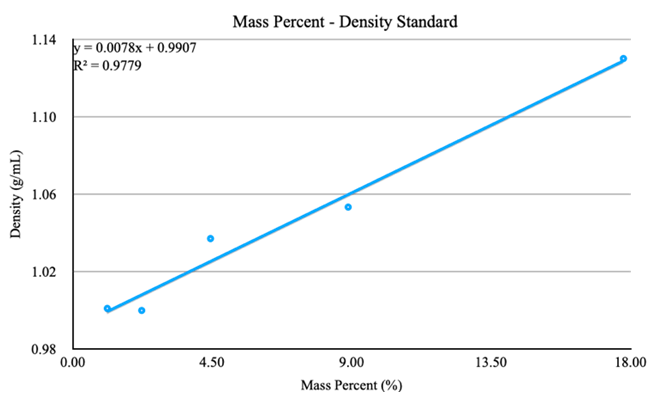 | Figure 1. Standard Curve that students in Chem 001A created |
3. Results
- The data obtained from the Blinded College helps determine the effects of CURE-based methods on students’ academic achievement. Overall success rates for CURE classrooms in comparison to traditional classrooms showed a significant increase of 23.2%. For the subcategories, females in CURE displayed a 92.7% success rate compared to traditional classroom success rate, 69.4% which is a 23.3% increase. For male students, the data displays a similar 23.3% increase in success rates from traditional classroom to CURE. As for progression rates, the CURE classrooms show a significant increase of 11.7%. For each subcategory, females show an increase of 16.4% in progression rate from traditional to CURE. Respectively, for males there is an increase of 9.9% in progression rate. (Table 2)
|
|
|
4. Conclusions
- The main purpose of this study is to investigate the effects CUREs has on a general chemistry course and the positive effects it has on female students’ motivation in chemical analysis. To explore our study, we used two different approaches to assess CURES on students' learning outcomes. The first approach was quantitative, which offered a direct comparison between traditional and CURE classroom success, progression, and progression success rates. These values were determined over a four-year span. Significant improvements were found in overall progression rate in which CUREs was implemented and in subcategory. The second approach was qualitative, which consisted of a compilation of surveys pre and post general chemistry sequence and gender is the major independent factor for analysis. Our study aims to draw attention to implementing CUREs at different levels in STEM education and in courses with higher enrollment rates. In addition, we also hope that expanding the CUREs curriculum could change introductory STEM courses as less of a filter to encourage female students to continue as science majors in the future.This was a study conducted at the Blinded College, a community college undergraduate institution. The class size for traditional and CURE classrooms were relatively small. The material taught for traditional and CURE classrooms is not identical so the discrepancies in results can be that some methods are more suitable for certain lectures and assignments. The differences in difficulty between the courses are also a factor of how the students perform within the class. Students may experience outlying factors that may not be the result of the traditional or CURE methods which affects their success rate and progression rate. The progression rate can also differ based on the required classes and major of the student which does not relate to classrooms’ approach. Despite these limitations, we feel our study captures the characteristics of CURE(s) integrated courses and displays potential solutions to gender inequity in STEM. These CURE projects are not exclusive to small classroom settings but can be adapted into infrastructures.Gender inequality is prevalent today in many different aspects. This includes the STEM classrooms our students today are enrolled in. The implementation of CUREs at the undergraduate level facilitates student learning while also engaging students in real world-based projects. This aids the inequity in STEM courses by allowing these individuals (women, minorities, etc.) to have more control over their learning and interest. To lead the next generation of STEM majors to success, CUREs allow for students to be able to problem solve, take control, and engage with their interest, and break out of a mold set by prior STEM norms. Everyone in STEM can build their own journey.
ACKNOWLEDGEMENTS
- This material is based in part upon work supported by the NSF (DUE 2000281). Any opinions, findings, and conclusions or recommendations expressed in this material are those of the author(s) and do not necessarily reflect the views of the NSF.
References
| [1] | Bilgin, Ibrahim. 2015. "The Effects of Project Based Learning on Undergraduate Students' Achievement and Self-Efficacy Beliefs towards Science Teaching." EURASIA Journal of Mathematics, Science & Technology Education 11: 469-477. |
| [2] | Bonwell. 1991. Active Learning: Creating Excitement in the Classroom. Washington, DC: George Washington University. |
| [3] | Bong, M., Skaalvik, E.M. Academic Self-Concept and Self-Efficacy: How Different Are They Really?. Educational Psychology Review 15, 1–40 (2003). |
| [4] | Brown, SD, Lent, RW Pajares, F, Urdan, T Preparing adolescents to make career decisions: A social cognitive perspective Adolescence and education: Vol. 5. Self-efficacy beliefs of adolescents 2006 Greenwich, CTInformation Age 201223. |
| [5] | Caruso. 2009. "Non-STEM undergraduates become enthusiastic phage-hunters." CBE Life Sci 8: 278-282. |
| [6] | Cengizhan, S. 2007. "The effects of project based and computer assisted instructional designs on those students' who have dependent, independent and cooperative learning styles, academic achievement and learning retention." Journal of Turkish Educational Sciences 377-401. |
| [7] | Choi, N. (2005), Self-efficacy and self-concept as predictors of college students' academic performance. Psychol. Schs., 42: 197-205. |
| [8] | Chun-Ming Hung1, Gwo-Jen Hwang2* and Iwen Huang1. 2011. "A Project-based Digital Storytelling Approach for Improving Students’ Learning Motivation, Problem-Solving Competence and Learning Achievement." Journal of Educational Technology & Society 15 (4): 368-379. |
| [9] | Demir, O. 2013. "Project-based learning approach in Turkish teaching lessons." Journal of mother Tongue Education 1: 53-76. |
| [10] | Dickson, Lisa. “Race and Gender Differences in College Major Choice.” The ANNALS of the American Academy of Political and Social Science, vol. 627, no. 1, 2010, pp. 108–124., https://doi.org/10.1177/0002716209348747. |
| [11] | Eagan MK, Hurtado, Chang MJ, Garcia GA, Herrera FA, Haribay JC. 2011. "Making a Difference in science education: the impact of undergraduate research programs." Res High Education 52: 151-177. |
| [12] | Ertl B, Luttenberger S and Paechter M (2017) The Impact of Gender Stereotypes on the Self-Concept of Female Students in STEM Subjects with an Under-Representation of Females. Front. Psychol. 8:703. doi: 10.3389/fpsyg.2017.00703. |
| [13] | Falk, N. A., Rottinghaus, P. J., Casanova, T. N., Borgen, F. H., & Betz, N. E. (2017). Expanding women’s participation in STEM: Insights from parallel measures of self-efficacy and interests. Journal of Career Assessment, 25(4), 571-584. |
| [14] | Freeman A. Hrabowski, III. 2014. " Institutional Change in Higher Education: Innovation and Collaboration." PEABODY JOURNAL OF EDUCATION 15. |
| [15] | Gillen, A., & Tanenbaum, C. (2014). Exploring gender imbalance among STEM doctoral degree recipients. Washington, DC: American Institutes for Research. |
| [16] | Hamurcu, H. 2004. "Project approach to teaching science in preschool education." Eurasion Journal of Educational Researcher 13: 66-72. |
| [17] | Jackson, D. L. (2013). A balancing act: Impacting and initiating the success of African American female community college transfer students in STEM into the HBCU environment. The Journal of Negro Education, 82(3), 255-271. 2014. "Institutional Change in Higher Education: Innovation and Collaboration." PEABODY JOURNAL OF EDUCATION 15. |
| [18] | Riegle-Crumb, C., & King, B. (2010). Questioning a white male advantage in STEM: Examining disparities in college major by gender and race/ethnicity. Educational Researcher, 39(9), 656-664. |
| [19] | Ritcher-Egger. 2010. "Improving Student Attitudes about Science by Integrating Research into the Introductory Chemistry Laboratory; Interdisciplinary Drinking Water Analysis." Chemical Education 87: 862-868. |
| [20] | Handbook of Competence and Motivation. (2013). United States: Guilford Publications. |
| [21] | Tomasik, Janice Hall. 2013. "Development and Preliminary Implementation of an Authentic Research-Based Experiment in General Chemistry." The American Chemical Society and Division of Chemical Education 90 (9): 1115-1161. |
| [22] | Vygotsky. 1978. Mind in society: The development of higher psychological processes. Cambridge, MA: Harvard University Press. |
| [23] | Wang, M. T., & Degol, J. L. (2017). Gender gap in science, technology, engineering, and mathematics (STEM): Current knowledge, implications for practice, policy, and future directions. Educational psychology review, 29(1), 119-140. |
| [24] | Weaver, Gabriela C, Cianan B Russell, and Donald J Wink. 2008. "Inquiry-based and Research-based Laboratory Pedagogies in Undergraduate Science." Nature Chemical Biology (4): 577-580. |
| [25] | Zacharias, Z & Barton. 2004. "Urban middle-school students’ attitudes toward a defined science." Science Education 197-222. |
| [26] | Zoller, U. 1990. "Environmental education and the university: the "problem-solving-decision making act" within a critical system-thinking framework." Higher Education in Europe 12: 5-14. |
| [27] | Usher, Ellen L., and Frank Pajares. “Sources of Self-Efficacy in School: Critical Review of the Literature and Future Directions.” Review of Educational Research, vol. 78, no. 4, 2008, pp. 751–796., https://doi.org/10.3102/0034654308321456. |
 Abstract
Abstract Reference
Reference Full-Text PDF
Full-Text PDF Full-text HTML
Full-text HTML